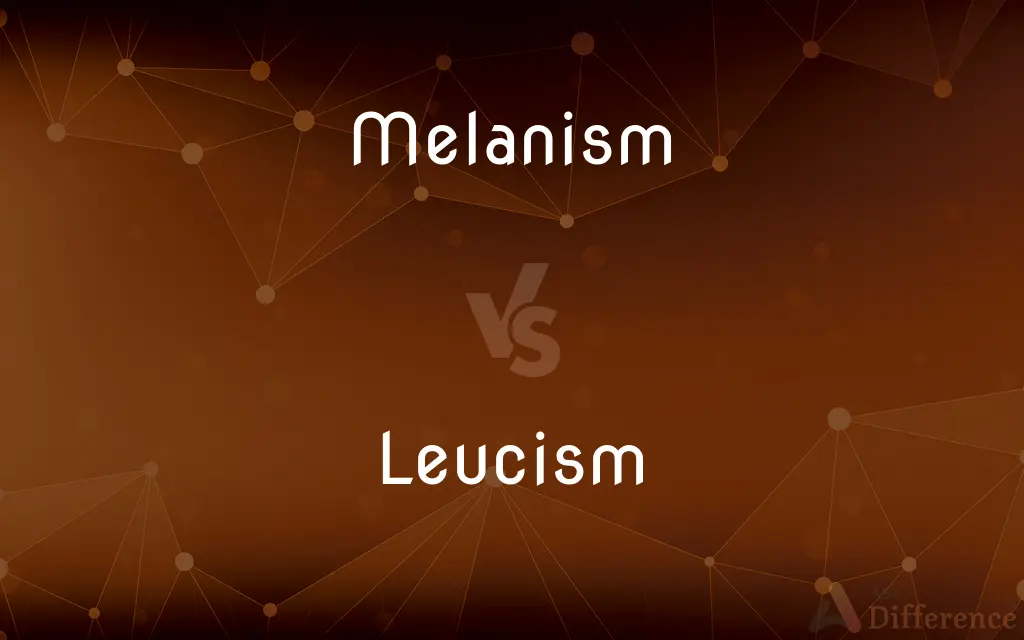Melanism vs. Leucism — What's the Difference?
By Tayyaba Rehman — Published on January 31, 2024
Melanism is the excessive development of dark pigmentation, melanin, in animals, leading to black or darker appearances. Leucism is a partial loss of pigmentation causing white or patchy coloring.

Difference Between Melanism and Leucism
Table of Contents
ADVERTISEMENT
Key Differences
Melanism refers to an increased presence of melanin, the dark pigment, in an animal's skin, fur, feathers, or scales, resulting in a black or darker-than-normal appearance. This can occur in various species and is often a genetic adaptation or mutation. Leucism, on the other hand, is characterized by a reduction in all types of skin pigment, not just melanin. This results in white, pale, or patchy coloration in animals, affecting the skin, fur, or feathers.
Animals with melanism often have a survival advantage in certain environments, such as darker habitats where they can camouflage better. This trait can be inherited and can appear in any species, but is especially notable in species like panthers, which are melanistic leopards or jaguars. Leucism, in contrast, might not confer such advantages, as it can make animals more visible to predators and less successful in hunting. Unlike albinism, leucistic animals do not have red or pink eyes, as their eye color is not affected by this condition.
The occurrence of melanism can vary widely among animal populations, influenced by environmental factors and genetic makeup. In some cases, it can be an adaptive response to environmental pressures like predation or climate. Leucism, while also genetic, is not typically an adaptive trait and is usually the result of a genetic mutation that affects pigment cell development.
In terms of identification, melanistic animals are often mistaken for being a different species due to their unusual color, but they are simply normal individuals with a high melanin concentration. Leucistic animals can be identified by their pale or patchy appearance, which is distinct from albinism, where there is a complete lack of melanin.
The study of melanism provides insights into evolutionary biology and genetics, as it is often a response to natural selection. Leucism, while less studied, offers a unique perspective on pigment development and genetic anomalies in animals.
ADVERTISEMENT
Comparison Chart
Pigmentation
Increased melanin, resulting in dark color
Reduced pigmentation, causing white or patchy color
Genetic Basis
Mutation or adaptation increasing melanin
Mutation causing reduction in pigment cells
Impact on Survival
Can offer camouflage and survival advantages
Usually does not offer survival advantages
Occurrence in Animals
Can be adaptive, influenced by environment
Typically not adaptive, results from mutation
Identification
Dark or black appearance, normal eye color
White or patchy coloration, normal eye color
Compare with Definitions
Melanism
A genetic trait causing darker coloring in animals.
Melanism in snakes results in unusually dark scales.
Leucism
A condition causing reduced pigmentation in animals.
The leucistic peacock displayed predominantly white feathers.
Melanism
Increased development of the dark pigment melanin.
The panther, a melanistic leopard, was nearly invisible in the night.
Leucism
Reduced pigment development in certain animals.
A leucistic lion was observed with a pale mane and coat.
Melanism
Excess melanin production leading to black or dark features.
The melanistic jaguar stood out for its strikingly dark coat.
Leucism
Partial loss of skin, fur, or feather pigmentation.
The leucistic deer was notable for its patchy, pale coat.
Melanism
Dark pigmentation adaptation in some animal species.
The melanism in moths was a response to industrial pollution.
Leucism
A condition distinct from albinism, lacking normal pigmentation.
Unlike albinos, leucistic animals retain normal eye color.
Melanism
A condition resulting in darker-than-normal appearance.
In birds, melanism can lead to entirely black plumage.
Leucism
Genetic mutation leading to white or patchy coloring.
Leucism in birds results in irregular white patterns on their plumage.
Melanism
See melanosis.
Leucism
A partial loss of pigmentation in a human or other animal, resulting in white, pale, or patchy coloration of the skin, hair, fur, or feathers but not the eyes.
Melanism
Dark coloration of the skin, hair, fur, or feathers because of a high concentration of melanin.
Leucism
An animal condition in which there is partial loss of pigmentation resulting in white, pale, or patchy coloration of the skin, hair, feathers, scales or cuticle, but not the eyes (caused by a reduction in multiple types of pigment, not just melanin).
Melanism
Congenital excess of melanin pigmentation in the skin, hair, feathers and/or eyes.
Melanism
An undue development of dark-colored pigment in the skin or its appendages; - the opposite of albinism.
Melanism
A disease; black jaundice. See Melæna.
Melanism
The character of having a high degree of pigmentation, as shown in dark skin, eyes, and hair.
Melanism
A condition characterized by abnormal deposits of melanin (especially in the skin)
Common Curiosities
What is leucism?
Leucism is a condition where animals have reduced pigmentation.
What does leucism look like in animals?
Animals appear white, pale, or patchy in color.
Is melanism common in certain species?
Yes, some species like panthers are known for melanism.
How does melanism affect an animal's appearance?
It results in a darker, often black appearance.
Are melanistic animals a different species?
No, they are the same species with a variation in color.
Can melanism provide a survival advantage?
Yes, especially in environments where darker coloration aids in camouflage.
Does leucism affect animal survival?
It can, as it may make animals more visible to predators.
What is melanism?
It's an increase in dark pigmentation, melanin, in animals.
Is leucism the same as albinism?
No, leucism is partial pigment loss, while albinism is a total lack.
Do leucistic animals have pink or red eyes?
No, unlike albinos, leucistic animals have normal eye color.
Are there studies on melanism and leucism in wildlife?
Yes, both conditions are studied for insights into genetics and animal adaptation.
How is melanism beneficial in some environments?
It helps in hiding from predators or while hunting in dark areas.
Can leucism be found in all animal species?
It can occur in many species, but it's not as common as melanism.
Can leucism be inherited?
Yes, it can be passed down genetically.
What causes melanism in animals?
It's usually caused by genetic mutations or adaptations.
Share Your Discovery

Previous Comparison
Proxy War vs. Cold War
Next Comparison
Allegra vs. ZyrtecAuthor Spotlight
Written by
Tayyaba RehmanTayyaba Rehman is a distinguished writer, currently serving as a primary contributor to askdifference.com. As a researcher in semantics and etymology, Tayyaba's passion for the complexity of languages and their distinctions has found a perfect home on the platform. Tayyaba delves into the intricacies of language, distinguishing between commonly confused words and phrases, thereby providing clarity for readers worldwide.
















































